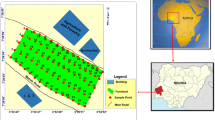Abstract
Thermal conductivity is a basic characteristic of the heat conduction properties of subsoil. Previous research shows that soil thermal conductivity has complex correlations with many soil physical parameters, such as dry density, water content, mineral composition and particle-size distribution. In this paper, several artificial intelligence calculation methods are used to study the soil heat conduction mechanism and establish predictive models of thermal conductivity: an artificial neural network (ANN), adaptive neural network-based fuzzy inference system (ANFIS) and support vector machine (SVM). Their modelling performance was evaluated by several metrics: correlation coefficient (R2), root mean square error (RMSE), mean absolute error (MAE) and variance account for (VAF). Monte Carlo simulation was used to verify the robustness of the models, and the results of traditional empirical relationship models are used for comparison. The ANN, ANFIS and SVM models can accurately predict soil thermal conductivity, with R2 > 0.89, RMSE < 0.22 (Wm−1 K−1), MAE < 0.14 (Wm−1 K−1) and VAF > 88%. The ANN model had the best predictive accuracy, with R2 = 0.9535, RMSE = 0.1338 (Wm−1 K−1), MAE = 0.0952 (Wm−1 K−1) and VAF = 95.25%. The SVM model had similar accuracy, while that of the ANFIS model was lower. Monte Carlo simulations show that the SVM model provided the most robust predictions and that all three models were significantly better than the traditional empirical models. The SVM model is suggested as the best model for predicting soil thermal conductivity.









Similar content being viewed by others
Abbreviations
- ANN:
-
Artificial neural network
- ANFIS:
-
Adaptive neural network-based fuzzy inference system
- SVM:
-
Support vector machine
- R 2 :
-
Correlation coefficient
- RMSE :
-
Root mean square error
- MAE :
-
Mean absolute error
- VAF :
-
Variance account for
- N 1, N 2, N k :
-
Input parameters
- Y :
-
Output parameter
- x max :
-
Maximum values
- x min :
-
Minimum values
- x :
-
Actual value
- x norm :
-
Normalized value
- λ dry :
-
Thermal conductivities of dry soil [Wm−1 K−1]
- λ sat :
-
Thermal conductivities of saturated soil [Wm−1 K−1]
- γ d :
-
Dry density [kgm−3]
- n :
-
Porosity [%]
- λ:
-
Thermal conductivity [Wm−1 K−1]
- H k :
-
The predicted value
- w x,ji :
-
Weighting factor
- bx,j :
-
Bias factor at the jth hidden node
- w y,j :
-
Weighting factor for the jth hidden node
- b y :
-
Bias factor in the output layer
- M :
-
Number of parameters evaluated by the same regression process
- N :
-
Sample number
- y 0 :
-
Measured value
- y p :
-
Predicted value
- m :
-
Number of Monte Carlo iterations
- S :
-
Actual random variable considered
- K e :
-
Normalized thermal conductivity of the soil
- S r :
-
Soil saturation
- λ water :
-
Thermal conductivities of water [Wm−1 K−1]
- λ solid :
-
Thermal conductivities of soil solid particles [Wm−1 K−1]
- κ :
-
Empirical parameters
- χ,η :
-
Influencing parameters of thermal conductivity of dry soil
- a, b:
-
Parameters related to dry soil
- α :
-
Reflects the influence of soil type on the Kersten variable
References
Latifi N, Latifi S, Meehan CL, Abd Majid MZ, Tahir MM, Mohamad ET (2016) Improvement of problematic soils with biopolymer-an environmentally friendly soil stabilizer. J Mater Civ Eng 29(2):04016204. https://doi.org/10.1061/(ASCE)MT.1943-5533.0001706
Adam D, Markiewicz R (2009) Energy from earth-coupled structures, foundations, tunnels and sewers. Géotechnique 59(3):229–236. https://doi.org/10.1680/geot.2009.59.3.229
Dong Y, Mccartney JS, Lu N (2015) Critical review of thermal conductivity models for unsaturated soils. Geotech Geol Eng 33(2):207–221. https://doi.org/10.1007/s10706-015-9843-2
Zhang M, Bi J, Chen W, Zhang X, Lu J (2018) Evaluation of calculation models for the thermal conductivity of soils. Int Commun Heat Mass 94:14–23. https://doi.org/10.1016/j.icheatmasstransfer.2018.02.005
Xu X, Zhang W, Fan C, Li G (2019) Effects of temperature, dry density and water content on the thermal conductivity of genhe silty clay. Results Phys 16:102830. https://doi.org/10.1016/j.rinp.2019.102830
Lu N, Dong Y (2015) Closed-form equation for thermal conductivity of unsaturated soils at room temperature. J Geotech Geoenviron Eng 141(6):04015016. https://doi.org/10.1061/(ASCE)GT.1943-5606.0001295
Kersten MS (1949) Thermal Properties of Soils. University of Minnesota Engineering Experiment Station, Minneapolis (Bulletin No. 28)
Coté J, Konrad JM (2005) A generalized thermal conductivity model for soils and construction materials. Can Geotech J 42(2):443–458. https://doi.org/10.1139/t04-106
Johansen O (1975) Thermal Conductivity of Soils. University of Trondheim, Trondheim, Norway (Ph.D. thesis)
Erzin Y, Rao BH, Singh DN (2008) Artificial neural network models for predicting soil thermal resistivity. Int J Therm Sci 47(10):1347–1358. https://doi.org/10.1016/j.ijthermalsci.2007.11.001
Wang J, Zhang X, Du L (2017) A laboratory study of the correlation between the thermal conductivity and electrical resistivity of soil. J Appl Geophys 145:12–16. https://doi.org/10.1016/j.jappgeo.2017.07.009
Zhang N, Zou H, Zhang L, Puppala AJ, Cai G (2020) A unified soil thermal conductivity model based on artificial neural network. Int J Therm Sci 155:106414. https://doi.org/10.1016/j.ijthermalsci.2020.106414
Bi J, Zhang MY, Lai YM (2020) A generalized model for calculating the thermal conductivity of freezing soils based on soil components and frost heave. Int J Heat Mass Tran 150:119166. https://doi.org/10.1016/j.ijheatmasstransfer.2019.119166
Wang JM, He HL, Li M, Dyck M, Si B, Lv JL (2020) A review and evaluation of thermal conductivity models of saturated soils. Arch Agron Soil Sci. https://doi.org/10.1080/03650340.2020.1771315
Zhang T, Cai G, Liu S, Puppala AJ (2017) Investigation on thermal characteristics and prediction models of soils. Int J Heat Mass Tran 106:1074–1086. https://doi.org/10.1016/j.ijheatmasstransfer.2016.10.084
Salomone LA, Kovacs WD (1984) Thermal resistivity of soils. J Geotech Eng 110(3):375–389. https://doi.org/10.1061/(ASCE)0733-9410(1984)110:3(375)
Chen SX (2008) Thermal conductivity of sands. Heat Mass Transf 44(10):1241–1246. https://doi.org/10.1007/s00231-007-0357-1
Horai KI (1971) Thermal conductivity of rock-forming minerals. J Geophys Res Atmos 76(5):1278–1308. https://doi.org/10.1029/JB076i005p01278
Barry-Macaulay D, Bouazza A, Singh RM, Wang B, Ranjith PG (2013) Thermal conductivity of soils and rocks from the Melbourne (Australia) region. Eng Geol 164:131–138. https://doi.org/10.1016/j.enggeo.2013.06.014
Popov Y, Tertychnyi V, Romushkevich R, Korobkov D, Pohl J (2003) Interrelations between thermal conductivity and other physical properties of rocks: experimental data. Pure Appl Geophys 160(5–6):1137–1161. https://doi.org/10.1007/PL00012565
Anand J, Somerton WH, Gomaa E (1973) Predicting thermal conductivities of formations from other known properties. Soc Pet Eng J 13(5):267–272. https://doi.org/10.2118/4171-PA
Brigaud F, Chapman DS, Douaran SL (1990) Estimating thermal conductivity in sedimentary basins using lithologic data and geophysical well logs. AAPG Bull 74(9):1459–1477. https://doi.org/10.1306/0c9b2501-1710-11d7-8645000102c1865d
Midttomme K, Roaldset E (1998) The effect of grain size on thermal conductivity of quartz sands and silts. Petrol Geosci 4(2):165–172. https://doi.org/10.1144/petgeo.4.2.165
Haigh SK (2012) Thermal conductivity of sands. Geotechnique 62(7):617–625. https://doi.org/10.1680/geot.11.P.043
Mitchell JK, Soga K (2005) Fundamentals of Soil Behavior. John Wiley & Sons, New York
Fausett LV (1994) Fundamentals of neural networks: architectures, algorithms, and applications. Pearson, Prentice-Hall
Hagan MT, Demuth HB, Beale MH (2002) Neural network design. China Machine Press, Beijing
Levenberg K (1944) A method for the solution of certain problems in least squares. Q Appl Math 2(2):164–168
Møller MF (1993) A scaled conjugate gradient algorithm for fast supervised learning. Neural Netw 6:525–533. https://doi.org/10.1016/S0893-6080(05)80056-5
Burden F, Winkler D (2009) Bayesian regularization of neural networks. Methods Mol Biol
Orbanic P, Fajdiga M (2003) A neural network approach to describing the fretting fatigue in aluminium-steel couplings. Int J Fatigue 25(3):201–207. https://doi.org/10.1016/S0142-1123(02)00113-5
Nguyen TA, Ly HB, Jaafari A, Pham TB (2020) Estimation of friction capacity of driven piles in clay using artificial neural network. Vietnam J Earth Sci 42(3):265–275. https://doi.org/10.15625/0866-7187/42/3/15182
Boubou R, Emeriault F, Kastner R (2010) Artificial neural network application for the prediction of ground surface movements induced by shield tunnelling. Can Geotech J 47(11):1214–1233. https://doi.org/10.1139/T10-023
Fei W, Narsilio GA, Disfani MM (2021) Predicting effective thermal conductivity in sands using an artificial neural network with multiscale microstructural parameters. Int J Heat Mass Tran 170:120997. https://doi.org/10.1016/j.ijheatmasstransfer.2021.120997
Shrestha D, Wuttke F (2020) Predicting the effective thermal conductivity of geo-materials using artificial neural networks. E3S Web Conf 205:04001. https://doi.org/10.1051/e3sconf/202020504001
Rizvi ZH, Akhtar SJ, Sabeeh WT, Wuttke F (2020) Effective thermal conductivity of unsaturated soils based on deep learning algorithm. E3S Web Conf 205:04006
Liu C, Hu X, Yao R, Han Y, Wang Y, He W, Fan H, Du L (2020) Assessment of Soil Thermal Conductivity Based on BPNN Optimized by Genetic Algorithm. Adv Civ Eng 2020(3):1–10. https://doi.org/10.1155/2020/6631666
Rizvi Z, Zaidi H, Shoarian Sattari A, Wuttke F (2019) Effective thermal conductivity of unsaturated sand using artificial neural network (ANN) and lattice element method (LEM). Int J Therm Sci
Chayjan RA, Montazer GA, Hashjin TT, Hadi M, Ghobadian B (2007) Prediction of Pistachio Thermal Conductivity Using Artificial Neural Network Approach. Int J Agric Biol 9(6):816–820. http://www.fspublishers.org
Fattahi H (2016) Indirect estimation of deformation modulus of an in situ rock mass: an anfis model based on grid partitioning, fuzzy c-means clustering and subtractive clustering. Geosci J 20(5):681–690. https://doi.org/10.1007/s12303-015-0065-7
Vapnik V (1999) The Nature of Statistical Learning Theory, 2nd edn. Springer, New York
Bui DT, Tran AT, Klempe H, Pradhan B, Revhaug I (2016) Spatial prediction models for shallow landslide hazards: a comparative assessment of the efficacy of support vector machines, artificial neural networks, kernel logistic regression, and logistic model tree. Landslides 13(2):361–378. https://doi.org/10.1007/s10346-015-0557-6
Tarnawski VR, McCombie ML, Leong WH, Wagner B, Momose T, Schönenberger J (2012) Canadian Field Soils II Modeling of Quartz Occurrence. Int J Thermophys 33(5):843–863. https://doi.org/10.1007/s10765-012-1184-2
Tarnawski VR, Momose T, Mccombie ML, Leong WH (2014) Canadian field soils iii thermal-conductivity data and modeling. Int J Thermophys 36(1):119–156. https://doi.org/10.1007/s10765-014-1793-z
Tarnawski VR, Leong WH (2016) Advanced Geometric Mean Model for Predicting Thermal Conductivity of Unsaturated Soils. Int J Thermophys 37(2):18. https://doi.org/10.1007/s10765-015-2024-y
Lin P, Ni P, Guo C, Mei G (2020) Mapping soil nail loads using Federal Highway Administration (FHWA) simplified models and artificial neural network technique. Can Geotech J 57(10):1453–1471. https://doi.org/10.1139/cgj-2019-0440
Gokceoglu C (2002) A fuzzy triangular chart to predict the uniaxial compressive strength of the ankara agglomerates from their petrographic composition. Eng Geol 66(1–2):39–51. https://doi.org/10.1016/S0013-7952(02)00023-6
Yukselen Y, Erzin Y (2008) Artificial neural networks approach for zeta potential of montmorillonite in the presence of different cations. Environ Geol 54(5):1059–1066. https://doi.org/10.1007/s00254-007-0872-x
Willmott CJ, Matsuura K (2005) Advantages of the mean absolute error (MAE) over the root mean square error (RMSE) in assessing average model performance. Clim Res 30:79–82. https://doi.org/10.3354/cr030079
Pham BT, Le LM, Le TT, Bui KTT, Prakash I (2020) Development of advanced artificial intelligence models for daily rainfall prediction. Atmos Res 237:104845. https://doi.org/10.1016/j.atmosres.2020.104845
Christian Pds (2012) Stochastic Models of Uncertainties in Computational Mechanics. Amer Society of Civil Engineers, Reston, VA
Guilleminot J, Soize C (2013) Stochastic model and generator for random fields with symmetry properties: application to the mesoscopic modelling of elastic random media. Multiscale Model Sim 11:840–870. https://doi.org/10.1137/120898346
De Vries DA (1963) Thermal properties of soils. In: Van Wijk WR (ed) Physics of the Plant Environment. John Wiley & Sons, New York, pp 210–235
Sass JH, Lachenbruch AH, Munroe RJ (1971) Thermal conductivity of rocks from measurements on fragments and its application to heat-flow determinations. J Geophys Res 76(14):3391–3401. https://doi.org/10.1029/JB076i014p03391
Lu S, Ren T, Gong Y, Horton R (2007) An improved model for predicting soil thermal conductivity from water content at room temperature. Soil Sci Soc Am J 71(1):8–14. https://doi.org/10.2136/sssaj2006.0041
Funding
Majority of the work presented in this paper was funded by the National Key R&D Program of China (Gran No. 2020YFC1807200), the National Natural Science Foundation of China (Grant No. 41877231, No. 42072299).
Author information
Authors and Affiliations
Corresponding author
Ethics declarations
Conflict of interest
On behalf of all authors, the corresponding author states that there is no conflict of interest.
Additional information
Publisher's Note
Springer Nature remains neutral with regard to jurisdictional claims in published maps and institutional affiliations.
Rights and permissions
About this article
Cite this article
Wang, C., Cai, G., Liu, X. et al. Prediction of soil thermal conductivity based on Intelligent computing model. Heat Mass Transfer 58, 1695–1708 (2022). https://doi.org/10.1007/s00231-022-03209-y
Received:
Accepted:
Published:
Issue Date:
DOI: https://doi.org/10.1007/s00231-022-03209-y




